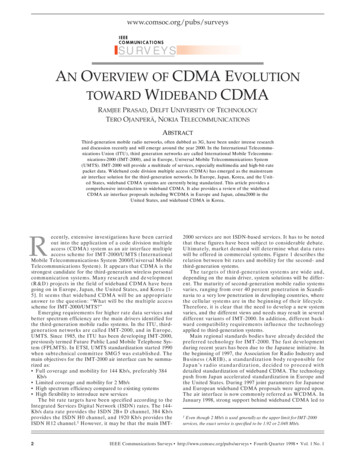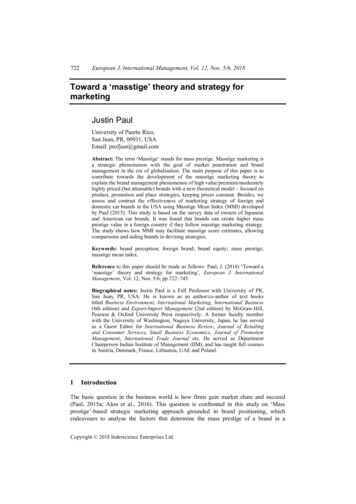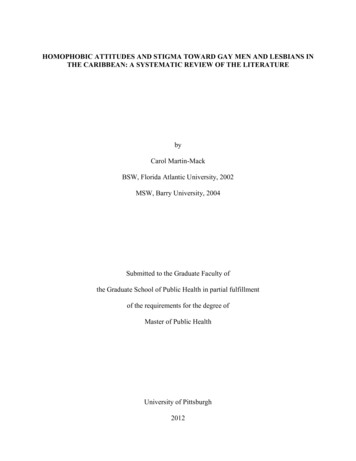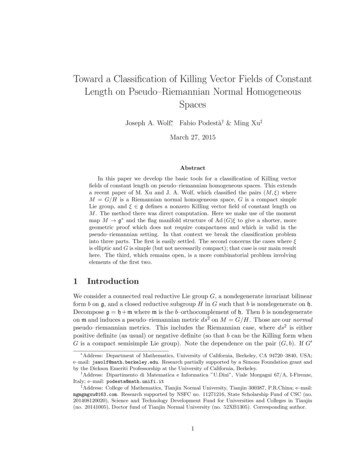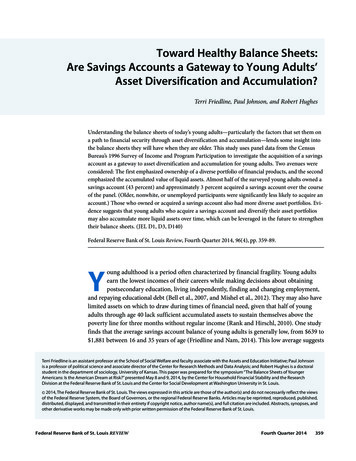
Transcription
Toward Healthy Balance Sheets:Are Savings Accounts a Gateway to Young Adults’Asset Diversification and Accumulation?Terri Friedline, Paul Johnson, and Robert HughesUnderstanding the balance sheets of today’s young adults—particularly the factors that set them ona path to financial security through asset diversification and accumulation—lends some insight intothe balance sheets they will have when they are older. This study uses panel data from the CensusBureau’s 1996 Survey of Income and Program Participation to investigate the acquisition of a savingsaccount as a gateway to asset diversification and accumulation for young adults. Two avenues wereconsidered: The first emphasized ownership of a diverse portfolio of financial products, and the secondemphasized the accumulated value of liquid assets. Almost half of the surveyed young adults owned asavings account (43 percent) and approximately 3 percent acquired a savings account over the courseof the panel. (Older, nonwhite, or unemployed participants were significantly less likely to acquire anaccount.) Those who owned or acquired a savings account also had more diverse asset portfolios. Evidence suggests that young adults who acquire a savings account and diversify their asset portfoliosmay also accumulate more liquid assets over time, which can be leveraged in the future to strengthentheir balance sheets. (JEL D1, D3, D140)Federal Reserve Bank of St. Louis Review, Fourth Quarter 2014, 96(4), pp. 359-89.oung adulthood is a period often characterized by financial fragility. Young adultsearn the lowest incomes of their careers while making decisions about obtainingpostsecondary education, living independently, finding and changing employment,and repaying educational debt (Bell et al., 2007, and Mishel et al., 2012). They may also havelimited assets on which to draw during times of financial need, given that half of youngadults through age 40 lack sufficient accumulated assets to sustain themselves above thepoverty line for three months without regular income (Rank and Hirschl, 2010). One studyfinds that the average savings account balance of young adults is generally low, from 639 to 1,881 between 16 and 35 years of age (Friedline and Nam, 2014). This low average suggestsYTerri Friedline is an assistant professor at the School of Social Welfare and faculty associate with the Assets and Education Initiative; Paul Johnsonis a professor of political science and associate director of the Center for Research Methods and Data Analysis; and Robert Hughes is a doctoralstudent in the department of sociology, University of Kansas. This paper was prepared for the symposium “The Balance Sheets of YoungerAmericans: Is the American Dream at Risk?” presented May 8 and 9, 2014, by the Center for Household Financial Stability and the ResearchDivision at the Federal Reserve Bank of St. Louis and the Center for Social Development at Washington University in St. Louis. 2014, The Federal Reserve Bank of St. Louis. The views expressed in this article are those of the author(s) and do not necessarily reflect the viewsof the Federal Reserve System, the Board of Governors, or the regional Federal Reserve Banks. Articles may be reprinted, reproduced, published,distributed, displayed, and transmitted in their entirety if copyright notice, author name(s), and full citation are included. Abstracts, synopses, andother derivative works may be made only with prior written permission of the Federal Reserve Bank of St. Louis.Federal Reserve Bank of St. Louis REVIEWFourth Quarter 2014359
Friedline, Johnson, Hughesyoung adults may have limited savings for even daily, lower-level financial needs such asgroceries, bills, rent, or auto repairs, let alone needs arising from educational debt or independent living that persist for several months or years.It is generally agreed that balance sheets consist of assets, debt, and net worth (Boshara,2012; Key, 2014; Mishkin, 1978), with an underlying assumption that saving, diversifying, andaccumulating assets lead to healthier balance sheets (Carasso and McKernan, 2007). Youngadults with lower accumulated liquid assets may have fragile balance sheets when healthybalance sheets are most needed. If young adults enter this period of life by accumulatingreserves and liquid assets through financial products such as savings, stock, and retirementaccounts, they may have the financial resources to better weather unexpected changes inemployment or living situations or to further invest in their futures. Their savings and liquidassets help to create a healthy balance sheet that likely sets them on a path to financial securityfrom which they can benefit throughout life. Understanding the savings and liquid assets oftoday’s young adults as part of their balance sheets lends some insight into their balance sheetswhen they are older, particularly with regard to factors that set them on a path to financialsecurity and, eventually, mobility.In this article, we attempt to provide an understanding of assets as one component of thebalance sheets of today’s young adults—that is, understanding the starting point for youngadults to acquire lifetime financial security. Given that savings accounts are one of the mostbasic products available from mainstream financial institutions and are hypothesized as astarting place or gateway to asset diversification and accumulation (Friedline and Elliott, 2013;Hogarth and O’Donnell, 2000; Sherraden, 1991; Xiao and Noring, 1994), this articles seeks toprovide a better understanding of the role of savings accounts in young adults’ balance sheets,particularly with regard to a diverse portfolio and the accumulation of liquid assets.A SAVINGS ACCOUNT AND THE FINANCIAL HIERARCHY OF ADIVERSE PORTFOLIOXiao and Anderson (1997) draw on Maslow’s (1948, 1954) human needs theory to showhow the financial products acquired by young adults may ascend a hierarchy based on theneeds the products are designed to meet. Human needs are assumed to be hierarchical, withthe achievement of higher-level needs conditional on the achievement of lower-level needs(Maslow, 1948, 1954). These assumptions have been applied to the acquisition and use offinancial products as they relate to lower- and higher-level needs (Xiao and Anderson, 1997;Xiao and Noring, 1994; Xiao and Olson, 1993). Notably, lower-level needs are referred to as“survival” and higher-level needs are referred to as “growth” (Xiao and Anderson, 1997),1 labelsthat also provide some indication of the achievement of financial security. From this perspective, a savings account is one of the first and most common financial products acquired becauseit is lower risk, easily liquidated, and designed for the achievement of daily, lower-level needs.Financial products such as stock and retirement accounts entail higher risk, have liquidityconstraints, and are designed for long-term investments and higher-level needs.360Fourth Quarter 2014Federal Reserve Bank of St. Louis REVIEW
Friedline, Johnson, HughesYoung adults may ascend a financial hierarchy by acquiring a savings account that facilitates their achievement of daily, lower-level needs such as buying groceries or paying utilitybills. Once acquired, young adults’ maintenance of their savings account to continue to meetlower-level needs may be guided in part by the inertia of behaviors regarding financial products(Benartzi and Thaler, 2007, and Madrian and Shea, 2001). As young adults transition to achieving long-term, higher-level needs, such as affording college tuition, the down payment on anew home, or inheritances they can provide to future generations, they may acquire stock andretirement accounts. A diverse portfolio, then, potentially indicates that young adults haveascended the financial hierarchy (De Brouwer, 2009; Canova, Rattazzi, and Webley, 2005; Xiaoand Anderson, 1997). This trend toward diversification is consistent with an optimal portfolioarrangement that spreads potential risk across multiple assets (Fabozzi, Gupta, and Markowitz,2002, and Markowitz, 1952), although the extent of diversification of most asset portfolios isgenerally limited (King and Leape, 1998).A GATEWAY TO HEALTHY BALANCE SHEETSThe financial products acquired by young adults as they ascend the financial hierarchymay serve as a gateway to diversifying and accumulating assets, nudging them toward healthybalance sheets. Young adults can leverage the assets accumulated in a diverse asset portfolioto their advantage for generating additional wealth throughout life (Friedline, Despard, andChowa, forthcoming; Friedline and Song, 2013; King and Leape, 1998). As such, a diverseportfolio may be an indicator of the ascension of the financial hierarchy to achieve higher-levelneeds, and the contribution of accumulated assets across the portfolio may be an indicator offinancial security (Beutler and Dickson, 2008; Canova, Rattazzi, and Webley, 2005; Xiao andAnderson, 1997). Holding a majority of liquid assets in a savings account might indicate theneed for easily liquidated assets, which might allude to inadequate funds to afford daily, lowerlevel needs. A majority of assets in stock or retirement accounts would be more complicated toliquidate and might indicate the existence of adequate funds to meet daily expenses and therefore represent investment in higher-level needs.Research confirms a decrease in accumulated amounts in savings accounts as assetsincrease (Xiao and Anderson, 1997); this suggests the contributions of the portfolio to assetaccumulation change with ascending the financial hierarchy. From this perspective, a savingsaccount may serve as a gateway for ascending the financial hierarchy as demonstrated by thedistribution of accumulated assets across the portfolio. For example, the amount held in a savings account contributes the most to accumulated liquid assets for households at the bottom10 percent of the asset distribution compared with the amounts held in stock and retirementaccounts for households at the top 10 percent of the distribution (Xiao and Anderson, 1997).Likewise, the most common trajectory from asset diversification to accumulation is to beginby accumulating assets in savings and checking accounts in early young adulthood and progressby accumulating assets through homeownership and stocks (Keister, 2003). It is much lesscommon for young adults to begin by accumulating assets in homes and stocks.The ascension of the financial hierarchy and distribution of accumulated assets could beinterpreted to mean that asset diversification must always precede accumulation. However,Federal Reserve Bank of St. Louis REVIEWFourth Quarter 2014361
Friedline, Johnson, Hughesthe relationship between diversification and accumulation is likely more nuanced. In writingabout the optimal portfolio arrangement, Sherraden (1990, p. 589) states “With greater assets,a household can more effectively diversify its holdings,” suggesting instead that asset accumulation precedes diversification. The question of “Which came first, a diverse portfolio oraccumulated assets?” is somewhat less perceptive than the question of “How does a diverseportfolio contribute to the value of accumulated assets?” Whereas the first question focuseson determining the causal direction of the relationship, the latter explores the correlation orpattern and composition of assets accumulated within the context of a diverse portfolio. Inother words, compared with young adults with either no account or only a savings account,young adults who own both savings and retirement accounts may be more financially secureand have a healthier balance sheet based on their accumulated liquid assets. This is because asavings account may represent lower-level needs, whereas savings and retirement accountsrepresent lower- and higher-level needs. If young adults acquire financial products contingenton a financial hierarchy that eventually develops into a diverse portfolio that can be leveragedto generate additional assets, then it is worth knowing how a diverse portfolio contributes tothe balance sheet.RESEARCH QUESTIONSThis article addresses the following questions to better understand how young adultsacquire a savings account and the role account acquisition plays in diversifying and accumulating assets:(i) What relates to the acquisition, or take-up, of a savings account by young adults aftercontrolling for relevant factors?(ii) Once a saving account is acquired, what fraction of young adults acquire otherfinancial products such as CDs, stock, and retirement accounts? In other words, isthe acquisition of a savings account a gateway to a diverse asset portfolio for youngadults?(iii) How much do the acquisition of a savings account and a diverse asset portfolio byyoung adults contribute to the value of their accumulated liquid assets after controlling for relevant factors?METHODSDataA large sample providing information at multiple and frequent time points was neededto analyze the acquisition of a savings account, asset diversification, and asset accumulationamong a young adult population over time. The Panel Study of Income Dynamics (PSID)and Survey of Consumer Finances (SCF) are often used to explore questions about wealth(including savings and assets; Curtin, Juster, and Morgan, 1989; Czajka, Jacobson, and Cody,2003; Wolff, 1999). However, these surveys have smaller sample sizes and an analysis can362Fourth Quarter 2014Federal Reserve Bank of St. Louis REVIEW
Friedline, Johnson, Hughesmeasure savings and assets only every other year at most, potentially missing sensitive changesthat occur monthly or quarterly. This study used data from the 1996 panel of the Survey ofIncome and Program Participation (SIPP) that were collected and made publicly availableby the Census Bureau. The 1996 SIPP data were collected during the 1990s, a decade of U.S.economic growth (Jorgenson, Ho, and Stiroh, 2008). Thus, the questions and data exploredin this article reflected balance sheets during generally favorable economic conditions (whenthe balance sheets of young adults might appear the most optimistic).2Between December 1995 and February 2000, the 1996 SIPP drew a random sample ofhouseholds grouped within geographic regions based on population counts from the mostrecent Census (U.S. Census Bureau, 2011), oversampling those with lower incomes (N 380,609individual respondents from 40,188 eligible households; n 1,634,357 number of rows). Eachhousehold member 15 years of age and older participated in data collection, which occurredeither quarterly or three times per year. During each interview, respondents recalled theirexperiences over the previous four months, thus resulting in 12 observations per year for a48-month time span on many variables. This allowed construction of monthly and quarterlyhistories of savings and asset diversification accounts of young adults for up to 48 months, whichwas ideal for addressing the research questions. Quarterly information was drawn from thefourth month in the reference period when respondents were interviewed in person, allowingexamination of changes in responses from one quarter to the next. The 1996 SIPP also collectedannual information in topical modules on special topics, including health, education, childcare, and accumulated assets. Annual information on liquid assets was collected in topicalmodules during waves 3, 6, 9, and 12 over the 48-month panel.Sample selection criteria included young adults between 18 and 40 years of age who provided reference month and topical module information and participated in at least two years’worth of data collection. Separate samples were produced from these two sources of information. Thus, a young adult who entered the sample at age 16 was included when he or she provided at least two years’ worth of information, making him or her age 18 at some time duringthe sampling frame. Likewise, two years’ worth of information was retained for a young adultwho entered the sample at age 40, making him or her age 42 at some time during the samplingframe. In other words, young adult respondents were included when age 18 would not be theirlast year of eligibility and when age 40 would not be their first year of eligibility. This restriction minimized the inclusion of young adults who cycled in or out of the 1996 SIPP within ashorter time, ensured more equal sample sizes across age groups, and reduced the number ofavailable rows in the data to 1,245,689 (a reduction of 24 percent). Based on these selectioncriteria, a total of 311,446 person-month observations for young adults were included in thereference month sample (n 30,601 individuals). There were 36,415 individuals included inthe topical module sample and 100,998 rows of data. This reduction in rows of data for thetopical module sample was expected given that the sample was followed on an annual basis asopposed to monthly or quarterly.The average age of young adults was 30; 48 percent of respondents were female and 82percent were white. Smaller percentages of Asians (4 percent) and other nonwhite groups(14 percent; blacks, Native Americans/First Peoples) were represented. Forty-three percent ofFederal Reserve Bank of St. Louis REVIEWFourth Quarter 2014363
Friedline, Johnson, HughesTable 1Sample whiteAsianMarital statusMarriedNot marriedCollege enrollmentFull-time enrollmentPart-time enrollmentNot enrolledEducation levelPrimary schoolSome high schoolHigh school diplomaSome collegeCollege degree or moreEmploymentEmployedPartially employedNot employedHousehold relationshipReference personChildRelativeNonrelativeNew reference personYesNoHomeownershipHomeownerNot a homeownerGeographic regionNortheastWestNorth CentralSouthMonthly earned incomeAge (yr)Reference month sample(n 30,601)Mean (SD)/percentTopical module sample(n 36,415)Mean 1564418222535 1,695 ( 2,278)31.889 (5.600)18222535 2,194 ( 2,644)29.760 (6.626)NOTE: The sample characteristics in this table are drawn from reference month data (n 311,446 person-monthobservations; n 30,601 individuals) and topical module data (n 36,415 individuals). Means and standard deviations(SDs; shown in parentheses) are reported for continuous variables and percentages are reported for categorical variables.SOURCE: Unweighted data from the 1996 SIPP.364Fourth Quarter 2014Federal Reserve Bank of St. Louis REVIEW
Friedline, Johnson, HughesTable 2Savings Account, Asset Diversification, and Accumulation CharacteristicsReference month sample(n 30,601)Mean (SD)/percentCovariatesTopical module sample(n 36,415)Mean (SD)/percentPercentage of savings account and financialproducts that comprise a diverse portfolio*Savings account4346Checking account242455CD accountMoney market account55Savings bond account1111Stock account1515Retirement account2425— 6,328( 79,498)Value of accumulated liquidassets†NOTE: The characteristics reported in this table are drawn from the reference month data (n 311,446 person-monthobservations; n 30,601 individuals) and topical module data (n 36,415 individuals). Percentages are reported forcategorical variables and medians and SDs (shown in parentheses) are reported for continuous variables. *Percentagesfor savings account and asset diversification strategies are presented for young adults who ever reported owning theseaccount types during the course of the panel using monthly level information. †Accumulated liquid assets are presentedfor young adults based on annual-level information. The accumulated mean value of liquid assets is reported only foryoung adults who held liquid assets greater than 0 and after the value was winsorized.SOURCE: Unweighted data from the 1996 SIPP.young adults had a savings account. Among those who accumulated liquid assets, the meanvalue totaled 6,328 (standa
savings account (43 percent) and approximately 3 percent acquired a savings account over the course of the panel. (Older, nonwhite, or unemployed participants were significantly less likely to acquire an account.) Those who owned or acquired a savings acco



